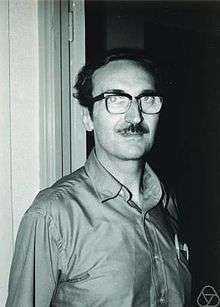Eugenio Calabi
Eugenio Calabi (born 11 May 1923 in Milan, Italy[1]) is an Italian-born American mathematician and the Thomas A. Scott Professor of Mathematics, Emeritus, at the University of Pennsylvania, specializing in differential geometry, partial differential equations and their applications.
Eugenio Calabi | |
|---|---|
 Eugenio Calabi | |
| Born | 11 May 1923 |
| Nationality | United States |
| Alma mater | Massachusetts Institute of Technology Princeton University (Ph.D.) |
| Known for | Calabi conjecture, work on differential geometry |
| Awards | Leroy P. Steele Prize (1991) Putnam Fellow (1946) |
| Scientific career | |
| Institutions | University of Pennsylvania University of Minnesota |
| Doctoral advisor | Salomon Bochner |
| Doctoral students | Xiu-Xiong Chen |
Academic career
Calabi was a Putnam Fellow as an undergraduate at the Massachusetts Institute of Technology in 1946. He received his Ph.D. in mathematics from Princeton University in 1950 after completing a doctoral dissertation, titled "Isometric complex analytic imbedding of Kahler manifolds", under the supervision of Salomon Bochner.[2] He later obtained a professorship at the University of Minnesota.
In 1964, Calabi joined the mathematics faculty at the University of Pennsylvania. Following the retirement of the German-born American mathematician Hans Rademacher, he was appointed to the Thomas A. Scott Professorship of Mathematics at the University of Pennsylvania in 1967. He won the Steele Prize from the American Mathematical Society in 1991 for his work in differential geometry. In 1994, Calabi assumed emeritus status. In 2012 he became a fellow of the American Mathematical Society.[3]
Calabi conjecture
His work on the Calabi conjecture for Kähler metrics led to the development of Calabi–Yau manifolds; these, and the study of constant scalar curvature Kähler metrics and extremal Kähler metrics introduced by him in 1982 are central topics in complex differential geometry.
Major publications
- Calabi, Eugenio. Isometric imbedding of complex manifolds. Ann. of Math. (2) 58 (1953), 1–23.
- Calabi, E. An extension of E. Hopf's maximum principle with an application to Riemannian geometry. Duke Math. J. 25 (1958), 45–56.
- Calabi, Eugenio. Improper affine hyperspheres of convex type and a generalization of a theorem by K. Jörgens. Michigan Math. J. 5 (1958), 105–126.
- Calabi, Eugenio. Minimal immersions of surfaces in Euclidean spheres. J. Differential Geometry 1 (1967), 111–125.
- Calabi, Eugenio. Examples of Bernstein problems for some nonlinear equations. 1970 Global Analysis (Proc. Sympos. Pure Math., Vol. XV, Berkeley, Calif., 1968) pp. 223–230 Amer. Math. Soc., Providence, R.I.
- Calabi, E. Métriques kählériennes et fibrés holomorphes. (French) [Kähler metrics and holomorphic vector bundles] Ann. Sci. École Norm. Sup. (4) 12 (1979), no. 2, 269–294.
- Calabi, Eugenio. Extremal Kähler metrics. Seminar on Differential Geometry, pp. 259–290, Ann. of Math. Stud., 102, Princeton Univ. Press, Princeton, N.J., 1982.
- Calabi, Eugenio. Extremal Kähler metrics. II. Differential geometry and complex analysis, 95–114, Springer, Berlin, 1985.
See also
- Calabi triangle
- Calabi flow
- Calabi–Yau algebra
- Calabi–Eckmann manifold
- Shing-Tung Yau (born 1949), a Chinese-born American mathematician awarded the Fields Medal in 1982
- Erich Kähler (1906–2000), a German mathematician
References
- American Men and Women of Science, Thomson Gale 2004
- Calabi, Eugenio (1951). Isometric complex analytic imbedding of Kahler manifolds.
- List of Fellows of the American Mathematical Society, retrieved 2012-11-10.